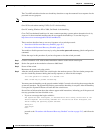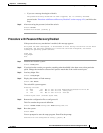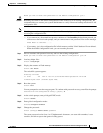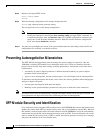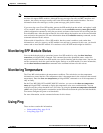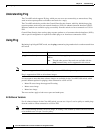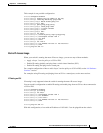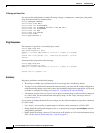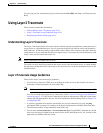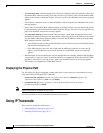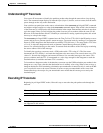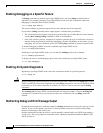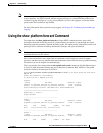
42-12
Cisco ME 3400 Ethernet Access Switch Software Configuration Guide
OL-9639-06
Chapter 42 Troubleshooting
Using Ping
IP Routing and Routed Port
You can use this configuration to enable IP routing, change a switchport to a routed port, and permit
pings from the switch to a connected host:
switch# configure terminal
switch(config)# int fa0/1
switch(config-if)# no switchport
switch(config-if)# ip address 192.168.1.1 255.255.255.0
switch(config-if)# no shutdown
switch(config-if)# exit
switch(config)# ip routing
switch(config)# end
switch# ping 192.168.1.2
Ping Responses
This response is typical of a successful ping to a host:
Switch# ping 72.20.52.3
Type escape sequence to abort.
Sending 5, 100-byte ICMP Echoes to 172.20.52.3, timeout is 2 seconds:
!!!!!
Success rate is 100 percent (5/5), round-trip min/avg/max = 1/2/4 ms
Switch#
An unsuccessful ping results in this message:
Switch# ping 72.20.52.3
Type escape sequence to abort.
Sending 5, 100-byte ICMP Echoes to 172.20.52.3, timeout is 2 seconds:
. . . . .
Success rate is 0 percent (0/5)
Summary
Keep these guidelines in mind while pinging:
• IP routing is available only with the metro IP access image and is disabled by default.
• To ping a host in a different IP subnetwork from the switch, you must have IP routing configured to
route between the subnets, and a static route to the destination might also be appropriate. If you need
to enable or configure IP routing, see
Chapter 35, “Configuring IP Unicast Routing.”
• All software versions can use a Layer 3 service policy to permit pings to and from a host connected
to a UNI or ENI. For more information about policy maps, see the
“Input and Output Policies”
section on page 33-4.
If your switch is running the metro IP access image, use one of these methods to ping a host connected
to a UNI or ENI:
• Use a Layer 3 service policy to permit pings to and from a host connected to a UNI or ENI.
• Enable global IP routing and configure a port as a routed port by using the no switchport interface
configuration command.
• Enable global IP routing, create an SVI, and assign an IP address to it. For more information about
SVIs, see the
“Switch Virtual Interfaces” section on page 9-5.



